Related Research Articles
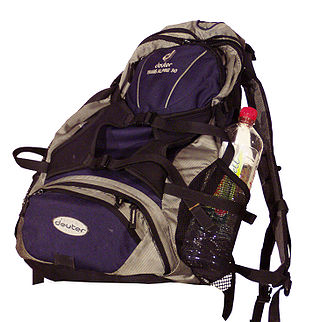
A backpack—also called knapsack, rucksack, pack, booksack, bookbag, haversack or backsack—is, in its simplest frameless form, a fabric sack carried on one's back and secured with two straps that go over the shoulders; but it can have an external or internal frame, and there are bodypacks.

Webbing is a strong fabric woven as a flat strip or tube of varying width and fibres, often used in place of rope. It is a versatile component used in climbing, slacklining, furniture manufacturing, automobile safety, auto racing, towing, parachuting, military apparel, load securing, and many other fields.

Modular Lightweight Load-carrying Equipment, or MOLLE (pronounced MOL-lee,, is the current generation of load-bearing equipment and backpacks used by a number of NATO armed forces, especially the British Army and the United States Army.

The Siebe Gorman Salvus is a light oxygen rebreather for industrial use or in shallow diving. Its duration on a filling is 30 to 40 minutes. It was very common in Britain during World War II and for a long time afterwards. Underwater the Salvus is very compact and can be used where a diver with a bigger breathing set cannot get in, such as inside cockpits of ditched aircraft. It was made by Siebe Gorman & Company, LTD in London, England. It was designed in the early 1900s.
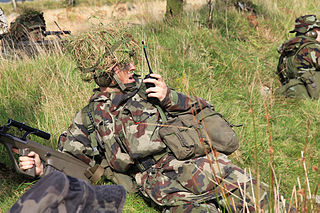
Personal load carrying equipment (PLCE) is one of several tactical webbing systems of the British Armed Forces. Dependent upon the year of design, and the decade of introduction, the webbing system was named and is commonly referred to as the 85 Pattern, the 90 Pattern or the 95 Pattern webbing.

A messenger bag is a type of sack, usually made of cloth. It is worn over one shoulder with a strap that goes across the chest resting the bag on the lower back. While messenger bags are sometimes used by couriers, they are now also an urban fashion icon. Some types of messenger bags are called carryalls. A smaller version is often called a sling bag.
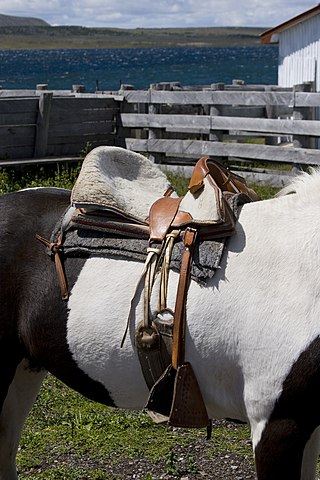
A girth, sometimes called a cinch, is a piece of equipment used to keep the saddle in place on a horse or other animal. It passes under the barrel of the equine, attached to the saddle on both sides by two or three leather straps called billets. Girths are used on Australian and English saddles, while western saddles and many pack saddles have a cinch, which is fastened to the saddle by a single wide leather strap on each side, called a latigo.
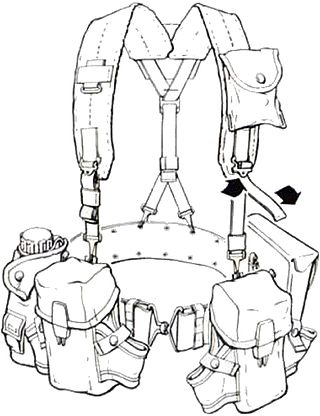
The all-purpose lightweight individual carrying equipment (ALICE) is a set of load-carrying equipment adopted as United States Army Standard A on 17 January 1973 to replace the M-1956 individual load-carrying equipment (ILCE) and M-1967 modernized load-carrying equipment (MLCE). Although since superseded by MOLLE, ALICE gear is still in some limited use with the U.S. Army National Guard, State Guard, also some ground units of the Navy and Air Force.

A Duluth pack, is a traditional portage pack used in canoe travel, particularly in the Boundary Waters region of northern Minnesota and the Quetico Provincial Park of Ontario. It is a specialized type of backpack that is designed to fit in the bottom of canoes. Originally known as the "Poirier pack" or "Poirier pack-sack", the pack style later became known as the "Duluth pack", as its original, eponymous manufacturing company is located in Duluth, Minnesota.

The IIFS was introduced in 1988, to serve as a fighting and existence carrying system—a possible replacement for the all-purpose lightweight individual carrying equipment (ALICE) employed and fielded by United States Armed Forces since 1973.
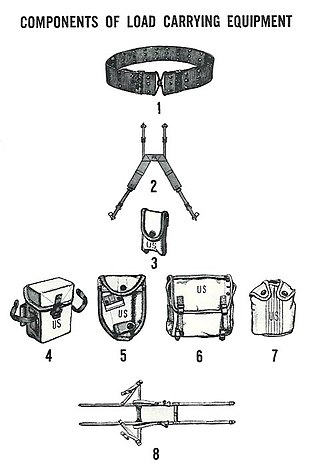
The M-1956 load-carrying equipment (LCE), also known as the individual load-carrying equipment (ILCE), was developed by the U.S. Army and first issued in the early 1960s. The M-1956 LCE was designed to replace the M-1945 Combat Pack, the M-1923 cartridge belt, the M-1936 pistol belt and the M-1937 BAR magazine belt. The M-1956 LCE was designed to be quickly configured, using no tools, to accommodate various mission and ammunition loads. The M-1956 LCE remained in service through the 1980s and set the standard for future United States military load-carrying equipment.

A haversack, musette bag, or small pack is a bag with a single shoulder strap. Although similar to a backpack, the single shoulder strap differentiates this type from other backpacks. There are exceptions to this general rule.
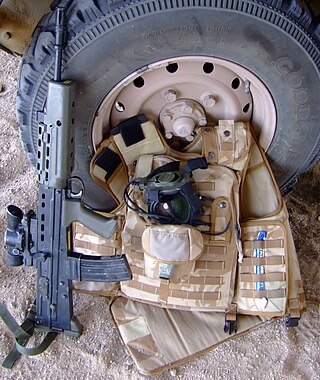
Osprey body armour is a system of body armour used by the British Armed Forces. The system is in its fourth iteration following extensive development and engagement with front line users.

1958 Pattern Web Equipment was a modular personal equipment system issued to the British Armed Forces from 1959 up until the mid 90s. It replaced the 1937 Pattern Web Equipment that had served the UK's Armed Forces through the Second World War and the first decade of the Cold War and also the 1944 pattern Webbing which was used in jungle conditions starting from the mid-1960s.

The Pouch Attachment Ladder System or PALS is a grid of webbing invented and patented by United States Army Natick Soldier Research, Development and Engineering Center used to attach smaller equipment onto load-bearing platforms, such as vests and backpacks. It was first used on MOLLE rucksacks, but is now found on a variety of tactical equipment, such as the U.S. Improved Outer Tactical Vest, Interceptor body armor, USMC Improved Load Bearing Equipment backpack and Modular Tactical Vest. It is used to attach items such as holsters, magazine pouches, radio pouches, knife sheathes, and other gear. A wide variety of pouches are commercially available, allowing soldiers to customize their kit. There is also a variety of attachment methods including the Alice Clip, the Natick snap, and soft, interwoven straps. The PALS system has begun to be adopted by other forces, such as the British Army, who use it on their Osprey body armor.

1937 pattern web equipment was an item of military load-carrying equipment. It replaced the 1908 pattern and 1925 pattern—on which it was based—and was standard issue for British and Commonwealth troops from its introduction in 1937, throughout World War II, and in the post-war period until it was superseded by 1958 pattern web equipment. It remained in limited use with Territorial Army and other second-line troops until the mid to late 1970s. Official use of the webbing in Community Cadet Forces and the Combined Cadet Force persisted into the 1980s.
The 1961 pattern webbing equipment, also referred to as the 63 Pattern and 61/64 Pattern, was the first load bearing equipment system of the Republic of South Africa, issued to the South African army. The system was copied by the Rhodesian army as the 69 pattern webbing.
The 1939 pattern webbing was an item of military load-carrying equipment used in the Second World War. It was a leather variant of the 1937 pattern web equipment.

The 1908 pattern web infantry equipment was an innovative type of webbing equipment adopted by the British Army before World War I.

The Ephod Combat Vest, also designated variously the A10 Model Infantry Load-bearing Rig, Individual Carrying Equipment, and "New style" Load Bearing Equipment, is a personal equipment system issued to the Israel Defense Forces (IDF) of the State of Israel since the mid-1970s. It replaced the modular-based 1950s "Old style" tan-khaki cotton canvas equipment and a variety of load-carrying waistcoats and assault vests used by Israeli infantry and elite units during the 1967 Six-Day War, the 1967-1970 War of Attrition, and the 1973 Yom Kippur War.